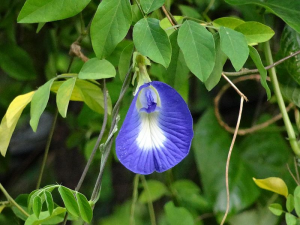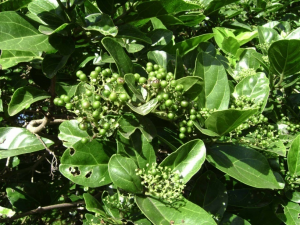Table of Contents
Aparajitha
Clitorea ternatea – Ayurvedic Herb
INTRODUCTION
Aparajita is delineated in Atharvaveda and wherein properties like Rakshoghna Krtyad usana, Yasasya are attributed to it. It is also considered as visahara . However in Brhat Trayi texts we do not come across the term Aparajita . Aparajita in however found in one context in Susruta uttara tantra
LITERARY REVIEW
According to Caraka : Aparajita is Sirovirecanopaga [useful in cleaning and moral therapy] According to Raja Nighantu : Aparajita is chakshushya [beneficial to eye in ophthalmopathy] According to Dhanwanthari Nigandu :Aparajita is vishadoshagni [which alternative toxins] Sushrutha also tells Aparajita is vishagna [which eliminates assure]
ADULTERANTS
- Sweta aparajita – Sreyasi now it identified as Rasna.
- Mahaswetha aparajitha.
- Katabhi- Albizza procera
- Ksudra sveda – Clitoria ternatea.
- Canscora decussate ( AD)
- Convolvulus pluricaulis (AD)
- Evolvulus alsinodes (AD)
VARIETIES
In Dhanvantari Nighantu two varieties sveta and neela; one with blue flowers and other with white flowers are described . Both are identified as [ Clitoria ternatea Linn – only White flowers – Clitoria ternatea Blue flowers – Clitoria ternatea
SYNONYMS
- Asphota
- Girikarni
- Vishnukranta
- Shankhapuspi
- Sephanda
- Sveta
- Maha sveta
- Ardra krauni
- Supushpi
- Mohanasini.
VERNACULAR NAMES
English – Clitoria Hindi – Aparajit , Koyala Kannada – Sanka pushpa Malayalam – Shanku pushpam Tamil – Adagi Tuvari, Thuvarai Punjabi – Arhar Gujarathi – Garnee Telgu – Dintena
USEFUL PARTS
- Root
- Root Bark
- Seeds
DOSAGE
Root powder – 1 – 3 g Seed powder – 1 – 2 g
INDICATIONS
Kushta Shotha Unmada Vrana Soola
KARMA
Tridosahara Medhya Visaghna Caksusya
FORMULATIONS
- Garbhapalarasa
- Aparajita beeja churna
- Aparajita moola choorna
CONTROVERSY
- Canscora deffusa
- Lavandular bipinnates
- Convolvulus Pluricaules
- Evolvulus alsinoides
PROPERTIES AND DOSHAGHNATA
- Rasa – Katu, thiktha ,kashaya
- Guna – Laghu, Rooksha
- Veerya – Sheetha
- Vipaka – Katu
- Doshagna – Thridashahara
CHEMICAL COMPOSITION
The root bark contains startch , tannin and resin. Seed: It contain oil, a bitter acid, resin, tannic acid, glucose [a light brown resin] and ash. The taste of the seeds is brittle and contains a cotyledon, which is full of granules starch . From leaves clitorin and Kaempferol have been isolated . A lactone aparajitin from leaves, sitosterol from seeds. Roots: Taronerol, anthescanthin. Flowers: Identification of cyanine chloride and kaempferol from flowers six acylated anthocyanins, A, B, C, D, E and F are isolated from blue flower along with kaempferol and its 3 glucoside, rohinin.
THERAPEUTIC USES
- Dhantha shoola : Root of Aparajita along with maricha is kent in the mouth[ Vai. Ma]
- Shodha : paste of girikarnika leaves is used internally/orally.
- Manasaroga : Root of white flowered . Aparajita is pounded with ruci water and used as nasya by mixing with ghee (R.M)
OTHER USES
Circulatory System : Being heamostatic and blood purifies , it is useful in haemorrhgic disorder and vatarakta . Hot infusion of dhamasa is given to prevent small pox. Respiratory system : It is used in common cold, cough, asthma as it acts as an expected ant and reduces the irritate of respiratory organs, besides this, whole plant is used for smoking . Decoction is used for gargling in throat manifestation. Manovah srotas : Dhamasa is applied over neck stiffeness Urinary system: It increases urination decoction is used as dysuria. Reproductive system: Being spermatogenic, it is given in semen debility. Satmikaras: It increases the physical strength and weight by unctuous and sweet. EXTERNAL USES:
- It alleviates swelling pain. It has haemostatic action hence it is used in miles specially bleeding piles. Piles are cleaned with the decection.
- Leaf juices normal drops in head ache.
- Oil boiled with dhamasa is used for massage in rheumatoid arthritis.
- Decoction is used for gargling in stomatic and far cleaning wounds. It prevents pus formation.
INTERNAL USES:
- It has a tranquilling affect on the brain hence it is used in symptoms like syncope, vertigo and brain weakness.
- It is an anti emetic, antidypiotic, mild lassitude and catalogue. It used in emesis.
ECOLOGY
Soil Requirements: Adapted to a wide range of soil types [ from sands to heavy clays of moderate fertility but is extremely well adapted to heavy clays alkaline soils and extremely on clay soils. Which are too shallow for lacuna .Adopted to pH 4.5 – 8.7 but prefer to medium to high Ph. Mositure : Requires summer rainfall of 500mm over 3 months but grows best between 700-1500 mm Drought tolerant and will survive in years which have only 400 mm rainfall and dry season of 5 – 6 months or longer even if heavily grazed. Temp : Warm reason growth up to 2000m in equatorial Africa and to latitude 24’S , Tolerate average daily temperature down. To 15 ‘C but not suited to districts with severe or frequent frosten. Light: Normally grown in full sunlight but moderately shade tolerate being used as a cover crop in coconut plantatres and under rubber. Reproductive develop : Flowers can develop on 4 – 6 weeks after sowing and continue to flowers which temperature and moisture are adequate.
RESEARCH STUDIES
- The present investigation was aimed at determining the spectrum of activity of the methanolic extract of Clitoria ternatea on the CNS.
- The CT was situated for its effect on cogitate behaviour, ansvelg, depression, stars. And comution induced by pentylenetrzol (PTZ) and mase electro stock ( MES)
- To explain these effect of CT was also studied. On behaviour medicated by dopamine, paradrenaline, seratonis and acelylcholine.
- The extract decreased time required to occupy the central platform flower .
- Flower used in herbal treatment.
- Recently it was found that it is best drug fer chikun gunia.











